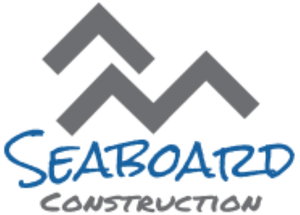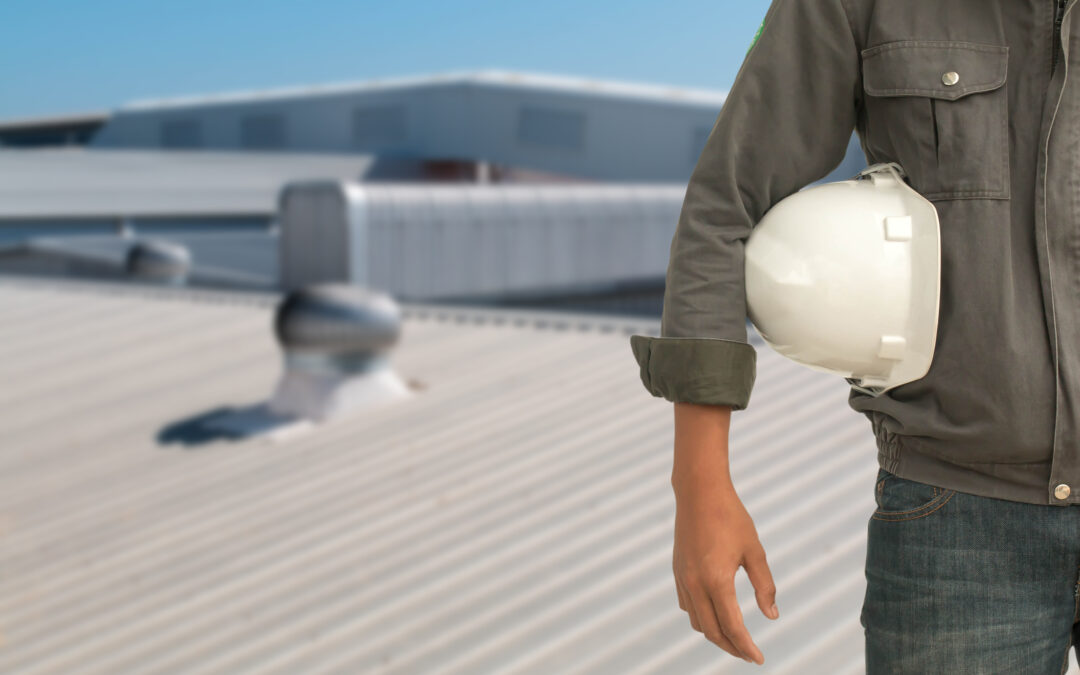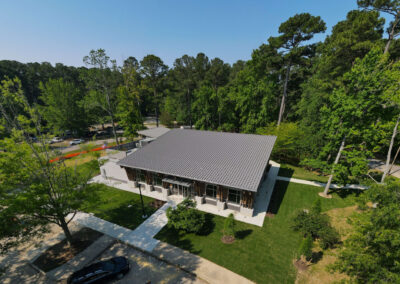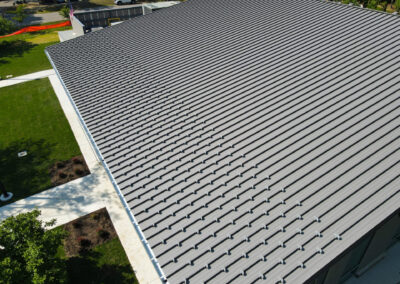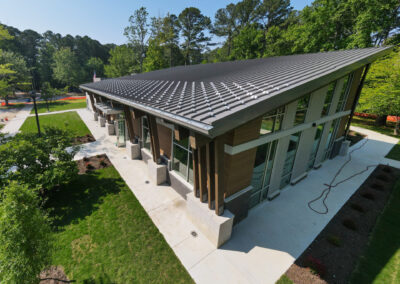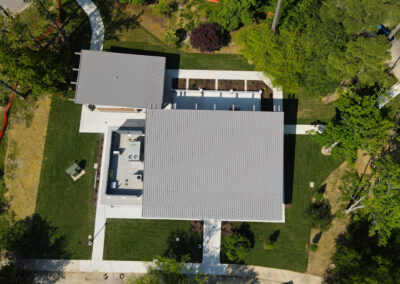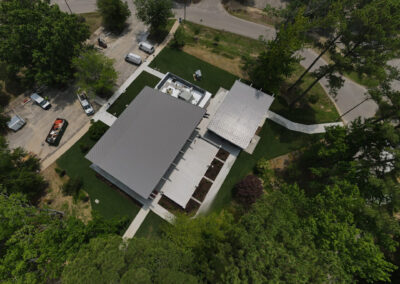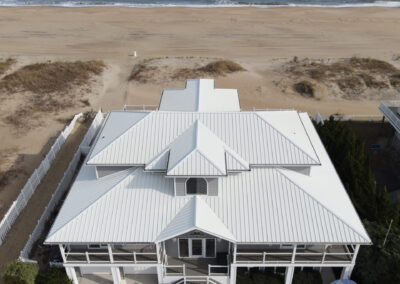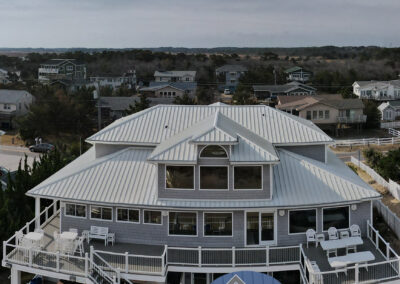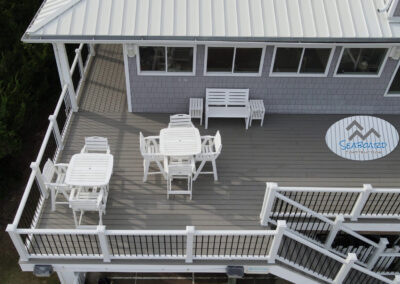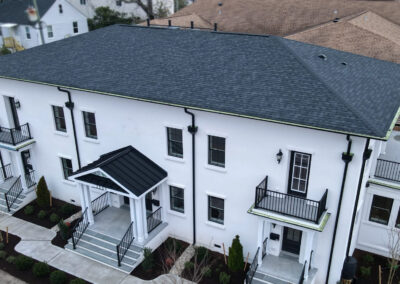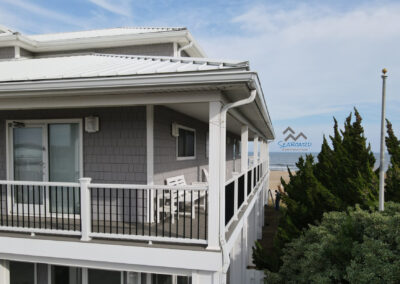Top Signs Your Commercial Roof Needs Replacement
Call 757-210-6580 to schedule a free roof inspection
In this article we’ll review the top signs your commercial roof must be replaced:
- Commercial Roof Importance: Commercial roofs serve as the initial defense against weather, safeguarding assets and employees.
- Signs of Deterioration: Signs of wear like separations at seams, cracks, and sunken areas indicate a deteriorating commercial roof.
- Indicators for Replacement: Signs that your commercial roof needs replacement include aging, ongoing leaks, sagging, severe weather damage.
- Role of Professional Inspection: Hiring a professional contractor for roof inspection ensures accurate assessment and proper maintenance recommendations.
- Choosing Roofing Materials: Different roofing materials like TPO, EPDM, PVC, and metal offer various benefits, durability, and cost-effectiveness.
- Metal Roofs for Commercial Buildings: Standing seam metal roofs stand out with their durability, energy efficiency, and aesthetic appeal for commercial properties.
- Energy Efficiency Impact: Well-maintained roofs enhance energy efficiency, reducing utility costs by preventing heat transfer and air leakage.
- Age and Lifespan: Lifespan varies, with TPO lasting 20-30 years, EPDM 20-25 years, PVC 20-30 years, and metal up to 70 years depending on material and care.
- Persistent Leaks: Ongoing leaks signal underlying roof issues and may indicate the need for a complete roof replacement.
- Safety and Functionality: Addressing roof problems promptly ensures the safety of occupants, prevents structural damage, and maintains HVAC efficiency.
The importance of maintaining a commercial roof
A commercial roof serves as the first line of defense against external elements, such as rain, wind, and snow. It shields your business and its valuable assets from the unpredictable forces of nature. Without proper maintenance, however, even the sturdiest roof can succumb to deterioration and compromise its protective capabilities. Regularly inspecting and maintaining your commercial roof is not only a matter of practicality, but it’s also a smart investment in the long-term success of your business. A well-maintained roof ensures the safety and comfort of your employees, protects your inventory and equipment, and upholds the professional image of your establishment. By acknowledging the importance of maintaining your commercial roof, you can avoid costly repairs and unexpected disruptions that may arise from neglecting its upkeep.
Overview of the signs you need a commercial roof replacement
Commercial roofs, typically composed of membrane materials such as TPO, EPDM, PVC, or even metal, can undergo wear and tear over time due to the constant exposure to environmental elements. As a crucial line of defense, these roofs shield commercial properties from rain, sun, wind, and temperature fluctuations. However, their protective capabilities may diminish as they age, leading to the need for replacement. Signs of deterioration often manifest as slight separations or lifting at the heat-welded seams, where two sheets of material converge. Cracking can also emerge, causing the roofing material to appear dry and weathered. Sunken areas might become apparent, particularly where leaks are more prone to occur. Recognizing these signs is vital to ensure the continued integrity of the roofing system, as a compromised commercial roof can pose substantial risks to the structure and occupants within.
Exploring the top signs that it’s time to replace your commercial roof
In this comprehensive blog post, we will delve into the key indicators that signal the need for a timely replacement of your commercial roof, whether it’s crafted from durable membrane materials like TPO, EPDM, PVC, or even sturdy metal. We understand that a well-maintained roof is essential to the overall safety and functionality of your commercial property. Through insightful analysis, we will explore the telltale signs of deterioration that these roofing systems might exhibit over time. From slight separations at the heat-welded seams to the appearance of cracks and dryness, we’ll guide you through the visual cues that suggest your roof is reaching the end of its lifespan.
By shedding light on these indicators, our aim is to empower business owners and property managers to make informed decisions about when to initiate the replacement process. With our expertise in roofing materials and extensive experience in the industry, we are dedicated to providing you with the knowledge you need to ensure the continued protection and resilience of your valuable commercial property.
Importance of a Well-Maintained Commercial Roof
Role of the roof in protecting the building and its contents
The roof of a commercial building plays a crucial role in providing protection against the elements. It acts as a shield, safeguarding the interior of the building and its valuable contents from rain, wind, and other weather conditions. A well-maintained roof prevents water intrusion, which can lead to structural damage, mold growth, and costly repairs. It also protects the building from excessive heat and UV rays, preserving the integrity of the materials used in construction. Furthermore, a secure roof enhances the overall safety of the occupants, preventing accidents or injuries caused by leaks or collapsing structures.
Impact of roof condition on energy efficiency and cost savings
The condition of a commercial roof directly affects the energy efficiency of the entire building. A well-maintained roof acts as an effective thermal barrier, preventing heat transfer and reducing the workload on heating, ventilation, and air conditioning (HVAC) systems. On the other hand, a damaged or deteriorated roof can lead to air leaks, allowing heat to escape during the colder months and enter during the warmer months. This inefficiency can significantly impact energy consumption and result in increased utility costs. By ensuring the proper maintenance of a commercial roof, such as repairing any leaks or replacing damaged insulation, businesses can achieve better energy efficiency, reduce their carbon footprint, and save on operational expenses in the long run.
The importance of regular inspections and maintenance
Regular inspections and maintenance play a pivotal role in extending the lifespan and ensuring the optimal performance of various roofing materials, including TPO, EPDM, PVC, and metal. For TPO roofs, routine inspections allow professionals to identify small issues before they escalate into more significant problems. These might include punctures, seams that are starting to lift, or signs of degradation due to exposure to UV radiation. Regular maintenance can involve resealing seams, addressing any tears or punctures, and ensuring proper drainage to prevent water pooling that could compromise the membrane’s integrity. Similarly, EPDM roofs benefit from scheduled inspections that help detect any developing issues. These could involve areas of the membrane that are becoming brittle or showing signs of wear due to weather exposure. Maintenance activities for EPDM might include sealing small cracks, repairing punctures, and checking the condition of flashing and edge details to prevent leaks and water intrusion.
PVC roofing materials also require consistent inspections and maintenance to retain their effectiveness. Regular checks can catch issues like punctures, seam separations, or signs of wear before they lead to water infiltration. Maintenance for PVC might involve heat-welding loose seams, repairing punctures with appropriate patching materials, and ensuring that drainage systems are functioning properly to avoid water buildup. Metal roofs, while highly durable, still benefit from routine attention. Inspections can identify loose or damaged panels, areas prone to corrosion, or compromised sealants around roof penetrations. Maintenance efforts for metal roofs might include resecuring loose panels, treating rusted areas, and replacing any damaged or deteriorated components.
Top Signs Your Commercial Roof Needs Replacement
Age of the Commercial Roof
Factors influencing the lifespan of different roofing materials
The longevity of roofing materials, such as TPO, EPDM, PVC, and metal, is influenced by a complex interplay of factors that determine their durability and performance over time. TPO (Thermoplastic Olefin), for instance, boasts remarkable resistance to UV rays, extreme temperatures, and chemicals. Its reflective properties also contribute to energy efficiency. EPDM (Ethylene Propylene Diene Monomer), known for its elasticity and durability, is highly resistant to weathering, making it an excellent choice for withstanding various environmental stresses. PVC (Polyvinyl Chloride) roofs are prized for their exceptional strength, chemical resistance, and fire retardant properties, enhancing their longevity and reliability.
On the other hand, metal roofing materials, like standing seam metal roofs, are renowned for their exceptional lifespan. Their robust construction, resistant to elements like water, fire, and pests, significantly contributes to their longevity. Moreover, proper installation and maintenance can further extend their life expectancy
General guidelines for the lifespan of commercial roofs
The lifespan of roofing materials such as TPO, EPDM, PVC, and metal can vary significantly based on factors like material quality, installation techniques, climate, and maintenance practices. TPO (Thermoplastic Olefin) roofing, known for its energy efficiency and reflective properties, typically has a lifespan of around 20 to 30 years. Proper installation and regular maintenance can help extend its longevity. EPDM (Ethylene Propylene Diene Terpolymer) roofs, made of a durable synthetic rubber, can last between 20 to 25 years or more with adequate care. Its resistance to UV radiation and extreme weather conditions contributes to its durability.
PVC (Polyvinyl Chloride) roofing, known for its exceptional strength and resistance to chemicals, can have a lifespan of 20 to 30 years or more. It offers excellent protection against weathering and is relatively low maintenance. On the other hand, metal roofing materials, including standing seam metal roofs, are renowned for their impressive longevity. Depending on the type of metal used (such as steel, aluminum, or copper) and the quality of the installation, metal roofs can last anywhere from 40 to over 70 years. Metal’s resistance to weather, UV rays, and other environmental stressors contributes to its extended lifespan.
Signs of aging and deterioration
As roofing materials like TPO, EPDM, PVC, and metal age, they may exhibit various signs of deterioration that warrant attention and potential replacement. TPO roofs, for instance, can show signs of aging through discoloration, surface cracking, and brittleness. These issues can compromise the material’s ability to provide a watertight barrier, leading to leaks and further damage. EPDM roofs may develop visible cracks, especially along seams and edges, as well as signs of shrinkage. The rubber-like material can lose its elasticity over time, making it susceptible to tearing and punctures, which can lead to water infiltration.
PVC roofs, while highly durable, can display signs of aging such as brittleness, cracking, and surface degradation. UV exposure can cause the material to become less flexible and more prone to damage. Metal roofing materials, including standing seam metal roofs, can experience corrosion over time due to exposure to moisture and environmental elements. Signs of deterioration can include rust spots, pitting, and paint peeling. Additionally, wear and tear can lead to loosening or separation of metal panels, potentially resulting in water intrusion and leaks.
Persistent Commercial Roof Leaks
Identifying and addressing ongoing roof leaks
Persistent roof leaks are a clear indication that there is a problem with the roof that needs to be addressed promptly. Identifying the source of the leak can sometimes be challenging, as water can travel along the roof’s surface before penetrating the interior of the building. However, signs of water stains on the ceiling, dripping water, or damp spots on walls or floors are telltale signs of ongoing roof leaks. When faced with persistent roof leaks, it is crucial to take immediate action. Temporary fixes such as patching or sealing may provide a temporary solution, but they do not address the underlying issues.
Indications of underlying issues requiring roof replacement
Persistent roof leaks can be indicative of underlying issues that may require a roof replacement. For instance, extensive leaks may suggest significant damage to the roofing material, such as extensive deterioration, corrosion, or punctures. Additionally, frequent leaks in multiple areas of the roof could indicate a more systemic problem with the roof’s structure or drainage system. If repairs are consistently required to address leaks, it may be more cost-effective and practical to consider a roof replacement rather than ongoing patchwork repairs. A professional roofing contractor can thoroughly assess the extent of the damage and provide recommendations for a suitable course of action.
Sagging or Uneven Commercial Roof
Causes of roof sagging and structural instability
Roof sagging or an uneven roof surface can be caused by various factors, and it is essential to identify the underlying causes to determine if a roof replacement is necessary. One common cause is inadequate structural support or poor construction practices during the initial installation of the roof. This can lead to insufficient load-bearing capacity, resulting in sagging over time. Additionally, excessive weight from accumulated snow or water can put stress on the roof structure, leading to sagging or even structural instability. Age-related deterioration, such as rotting or weakened roof decking, can also contribute to a sagging roof.
Risks associated with a sagging or uneven roof
A sagging or uneven commercial roof poses significant risks to the building, its occupants, and the overall structural integrity. Firstly, it compromises the roof’s ability to shed water effectively, leading to water pooling and increased risk of leaks and water damage. The added weight of water accumulation can further exacerbate the sagging and increase the potential for structural collapse. A sagging roof can also impact the functionality of the HVAC system, causing inefficiencies in temperature regulation and potentially increasing energy costs. Additionally, an uneven roof surface can create tripping hazards and pose safety risks for maintenance personnel who need to access the roof for repairs or inspections. Recognizing the risks associated with a sagging or uneven roof underscores the importance of addressing the issue promptly to ensure the safety of the building
Commercial Roofers in Virginia
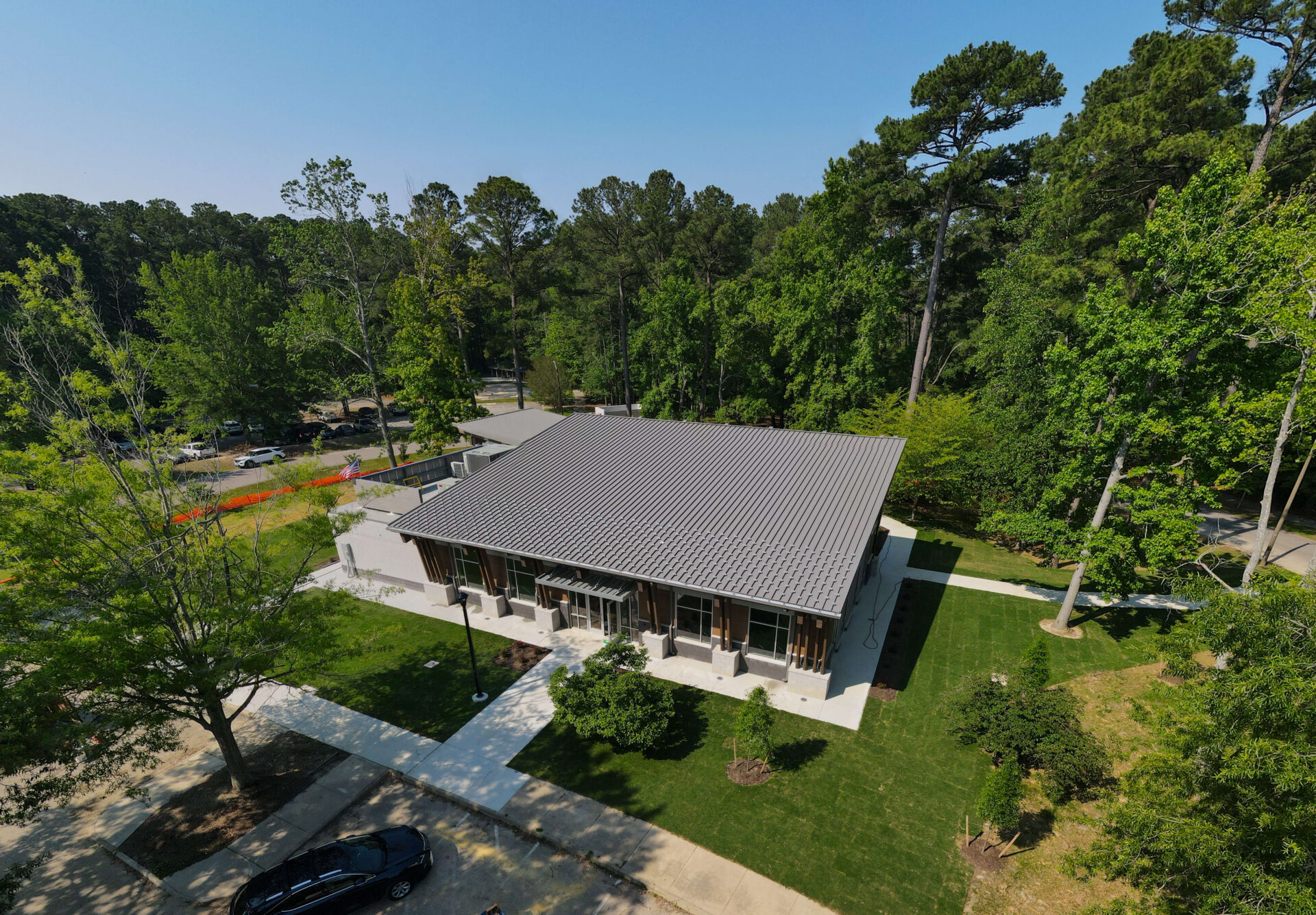
Hampton Roads Commercial Roofing Company
Extensive Commercial Roof Damage from Weather
Assessing damage from severe weather events (hail, storms, etc.)
Call now 757-210-6580
Assessing damage from severe weather events is a critical aspect of maintaining the integrity of roofing materials like TPO, EPDM, PVC, and metal. Each material responds differently to various weather challenges. For TPO roofs, hail storms can cause punctures and tears, compromising the membrane’s waterproofing properties. Inspecting the surface for cracks, punctures, or loosened seams is essential after severe weather. EPDM roofs, although highly durable, can also suffer from hail damage in the form of punctures or tears. Additionally, windstorms might lead to the edges of the membrane lifting. Regular inspections post-weather events are crucial to identifying any signs of deterioration or damage.
PVC roofing materials are renowned for their resilience, yet even they can be affected by severe weather conditions. Hailstorms can result in surface cracks or punctures, while strong winds may cause the membrane to lift. Vigilant post-storm assessments are essential to catch such issues early. Metal roofs, known for their durability, generally fare well against severe weather. They are highly resistant to impact from hail and provide strong protection against storms. However, metal roofs can still sustain cosmetic damage such as dents from large hailstones.
Determining the extent of damage requiring roof replacement
Determining the extent of damage that necessitates a roof replacement is a crucial decision for various roofing materials, including TPO, EPDM, PVC, and metal. For TPO roofs, extensive damage might involve widespread punctures, tears, or seam separations that compromise the membrane’s waterproofing ability. Additionally, if a significant portion of the TPO membrane is showing signs of deterioration, replacement could be a more cost-effective solution in the long run. EPDM roofs require attention to large punctures, tears, or cracks that compromise the waterproof barrier. If a substantial portion of the EPDM membrane is damaged, and repairs would be patchwork in nature, a complete replacement might be the best course of action. Inspecting the overall condition of the roof and assessing the cumulative effect of damages are important factors in the decision-making process.
PVC roofing materials are known for their durability, but extensive damage can still warrant replacement. Large punctures, tears, or numerous areas of damage that compromise the integrity of the membrane can necessitate a new roof. Additionally, if the PVC membrane has reached the end of its expected lifespan and is showing widespread signs of wear, a replacement might be more cost-effective than continually repairing individual issues. Metal roofs are built to last, but severe and widespread damage can warrant replacement. If a significant number of metal panels are dented, bent, or dislodged due to severe weather or other factors, the structural integrity of the roof could be compromised. Furthermore, if the metal roof has reached the end of its expected lifespan and is exhibiting signs of corrosion or rust, a replacement might be the most prudent decision to ensure continued protection.
The Role of Professional Commercial Roof Inspection
Benefits of hiring a professional roofing contractor for a commercial roof inspection
Hiring a professional roofing contractor like Seaboard Construction for a commercial roof inspection offers several benefits. Firstly, professional contractors have the expertise and experience to accurately assess the condition of the roof. They are trained to identify potential issues that may not be apparent to an untrained eye. Additionally, professional contractors have the necessary tools and equipment to conduct a thorough inspection, including accessing hard-to-reach areas safely. Moreover, they stay updated with the latest industry standards and regulations, ensuring that the inspection is conducted in accordance with best practices. Hiring a professional roofing contractor for a commercial roof inspection provides peace of mind, knowing that the inspection will be comprehensive, accurate, and conducted by knowledgeable professionals who can provide expert advice on maintenance, repairs, or the need for a roof replacement.
Importance of a thorough inspection in identifying signs of roof replacement
A thorough inspection of a commercial roof is crucial in identifying signs that indicate the need for a roof replacement. Professional contractors can assess the overall condition of the roof, examining not only the visible surface but also the underlying structure and components. They can identify signs of aging, deterioration, or damage that may require a roof replacement, such as extensive cracks, widespread material deterioration, or compromised structural integrity.
A thorough inspection also helps in identifying underlying issues that may not be immediately visible, such as water infiltration points, inadequate ventilation, or poor drainage. By identifying these signs early on, business owners can make informed decisions about whether a roof replacement is necessary to address the identified issues effectively. A professional inspection provides a comprehensive evaluation of the roof’s condition and serves as a valuable tool in determining the best course of action for maintaining the roof’s performance and longevity.
Choosing the Right Roofing Material for Commercial Roof Replacement
Overview of different roofing materials for commercial applications
When considering a commercial roof replacement, it’s important to be aware of the various roofing materials available. Some common options include single-ply membranes (such as EPDM or TPO), built-up roofing (BUR), and metal roofs. Each material has its own characteristics and suitability for different commercial applications. However, one roofing material that stands out is the standing seam metal roof. Standing seam metal roofs are known for their durability, longevity, and aesthetic appeal. They are composed of metal panels with vertical seams that interlock to create a watertight barrier. This type of roof offers exceptional resistance to wind, rain, snow, and fire, making it an excellent choice for commercial buildings.
Comparing their benefits, durability, and cost-effectiveness
When comparing the benefits, durability, and cost-effectiveness of different roofing materials such as TPO, EPDM, PVC, and metal, it’s essential to consider the unique qualities each material brings to the table. TPO (Thermoplastic Olefin) roofing is prized for its energy efficiency, as its reflective surface helps reduce heat absorption and cooling costs. TPO membranes are known for their resistance to UV radiation, chemicals, and algae growth. However, TPO roofs can be vulnerable to punctures and may require regular inspections to identify potential issues early. On the other hand, EPDM (Ethylene Propylene Diene Monomer) roofing offers excellent durability and flexibility. EPDM membranes are highly resistant to weathering, UV exposure, and thermal fluctuations. They can adapt well to building movement and exhibit superior performance in cold climates. However, EPDM roofs may have a higher initial cost due to the material’s quality.
PVC (Polyvinyl Chloride) roofing combines durability and energy efficiency, making it a preferred choice for many commercial properties. PVC membranes offer strong resistance to UV radiation, chemicals, and fire. They are also energy-efficient due to their reflective surface. PVC roofs are known for their longevity, and while they may have a slightly higher upfront cost, their durability often translates to lower long-term maintenance expenses. Metal roofing, such as standing seam metal roofs, is celebrated for its unmatched longevity and durability. Metal roofs are resistant to various environmental factors, including UV exposure, high winds, and fire. They have a minimal maintenance requirement, and their lifespan can exceed 50 years. While metal roofing may have a higher initial cost compared to other materials, its exceptional durability and energy-saving benefits contribute to a solid return on investment over time. Assessing these factors alongside budget considerations can guide property owners in making the right roofing material choice for their specific needs and circumstances.
Highlighting the advantages of metal roofs for commercial buildings
Standing seam metal roofs offer several advantages that make them a preferred choice for commercial buildings. Firstly, their durability is unmatched. Metal roofs can withstand severe weather conditions, including high winds, hailstorms, and heavy snow loads. They are resistant to corrosion and can last 40-60 years or more, making them a long-term solution. Additionally, standing seam metal roofs provide superior energy efficiency.
The reflective surface of the metal helps to reduce heat absorption, lowering cooling costs during hot summer months. Metal roofs are also environmentally friendly as they can be made from recycled materials and are fully recyclable at the end of their lifespan. Furthermore, the sleek and modern aesthetic of standing seam metal roofs adds an attractive and professional appearance to commercial buildings, enhancing their overall appeal and value. With their exceptional durability, energy efficiency, and aesthetic advantages, standing seam metal roofs are an excellent choice for commercial roof replacements.
Wrapping Up: Signs You Need A Commercial Roof Replacement
Recap of the top signs indicating the need for commercial roof replacement
It is crucial to be aware of the top signs that indicate the need for commercial roof replacement. These signs include the age and visible deterioration of the roof, frequent roof leaks, sagging or uneven roof surfaces, extensive damage from weather or natural disasters. By recognizing these signs early on, businesses can proactively address potential issues and prevent further damage or disruptions.
Importance of choosing the right roofing materials for your commercial roof
Choosing the right roofing materials for your commercial roof is of utmost importance. While there are various options available, standing seam metal roofs stand out as an excellent choice. They offer exceptional durability, longevity, and resistance to weather elements, making them a reliable and long-lasting solution for commercial buildings. Metal roofs also provide energy efficiency benefits, are environmentally friendly, and add a sleek and modern aesthetic to commercial structures.
Take action if your commercial roof shows any signs of needing to be replaced
If your commercial roof shows any signs indicating the need for replacement, it is crucial to take action promptly. Ignoring or delaying roof replacement can lead to more extensive damage, increased repair costs, and potential disruptions to your business operations. Consult with a professional roofing contractor to assess the condition of your roof, discuss the signs you have observed, and explore the options available to you. Consider the benefits of standing seam metal roofs, such as their durability, energy efficiency, and aesthetic appeal, when choosing the right roofing materials for your commercial roof. By being proactive and selecting the appropriate roofing materials, you can ensure the long-term performance, protection, and value of your commercial building.
Commercial Metal Roof Photo Gallery
Call 757-210-6580
Commercial Roof Replacements
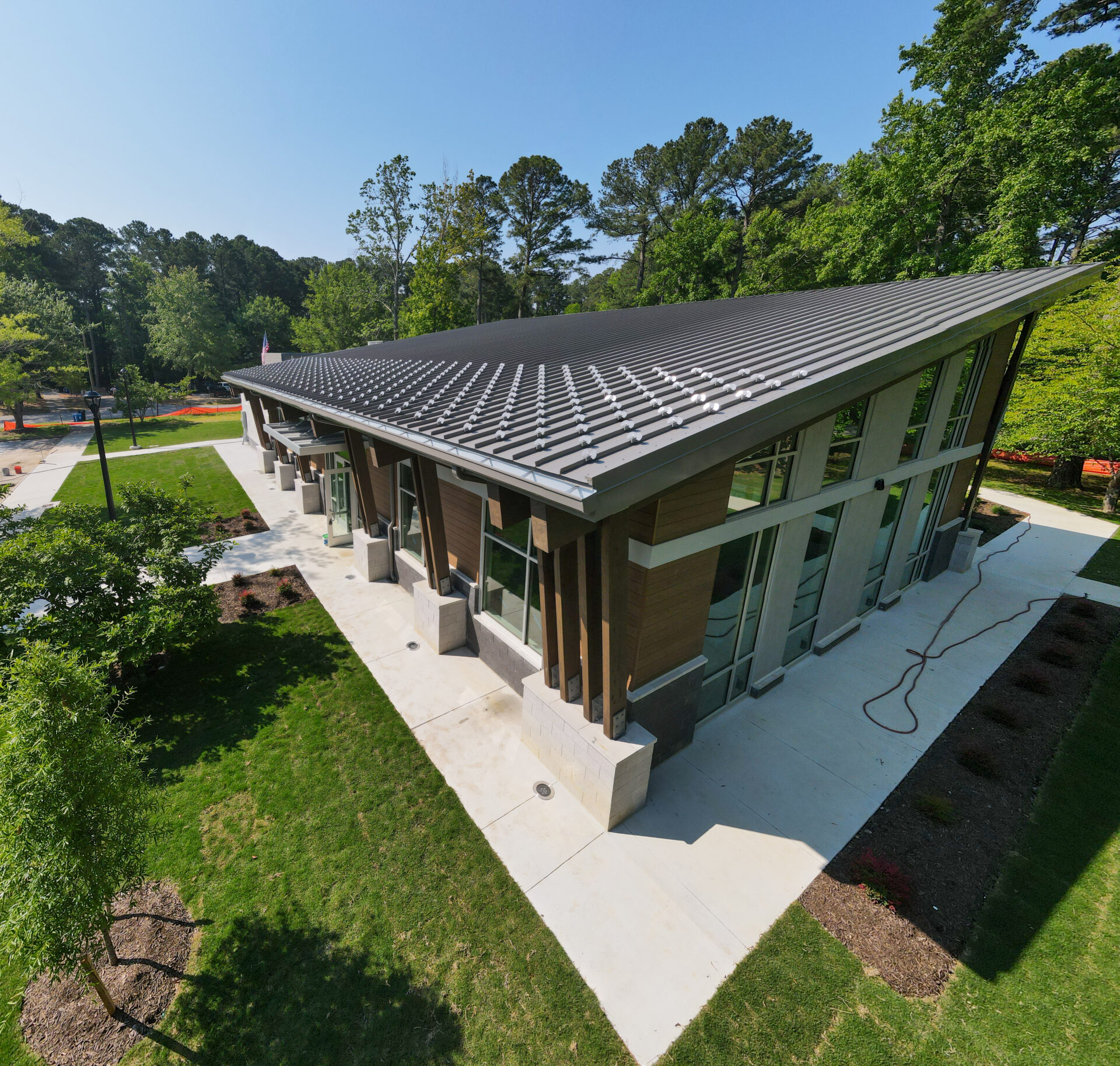
Schedule A Roof Inspection
Call 757-210-6580 or fill out our form
Licensed & Insured Class A Contractor
Hours & Address
Hours
MONDAY – SUNDAY
7:00am – 6:00pm
